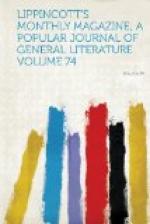The dry-leaf process depends also upon maceration, the leaves being cropped from the ripe plant, and dried in the hot sunshine during two days, from nine in the morning until four in the afternoon.
On the next day, at an early hour in the morning, my companion and I betook us to the Plain of Alms. I have before mentioned that Allahabad, the ancient city of Prayaga, is doubly sanctified because it is at the junction of the Jumna and the Gauges, and these two streams are affluents of its sanctity as well as of its trade. The great plain of white sand which is enclosed between the blue lake-like expanses of the two meeting rivers is the Plain of Alms. In truth, there are three rivers which unite here—the Ganges, the Jumna and the Saravasti—and this thrice-hallowed spot is known in the Hindu mythologic system as the Triveni.
“But where is the third?” I asked as we stood gazing across the unearthly-looking reaches of white sand far down the blue sweep of the mysterious waters.
“Thereby hangs a tale,” replied my companion. “It is invisible here, but I will show you what remains of it presently when we get into the fort. Here is a crowd of pilgrims coming to bathe in the purifying waters of the confluence: let us follow them.”
As they reached the shore a Brahman left his position under a great parasol and placed himself in front of the troop of believers, who, without regard to sex, immediately divested themselves of all clothing except a narrow cloth about the loins, and followed him into the water. Here they proceeded to imitate his motions, just as pupils in a calisthenic class follow the movements of their teacher, until the ceremonies of purification were all accomplished.
[Illustration: GRAIN-AND-FLOUR MERCHANT OF PATNA.]
“A most villainous-faced penitent!” I exclaimed as one of their number came out, and, as if wearied by his exertions, lay down near us on the sand.
Bhima Gandharva showed his teeth: “He is what your American soldiers called in the late war a substitute. Some rich Hindu, off somewhere in India, has found the burden of his sins pressing heavily upon him, while at the same time the cares of this world, or maybe bodily infirmities, prevent him from visiting the Triveni. Hence, by the most natural arrangement in the world, he has hired this man to come in his place and accomplish his absolution for him.”




